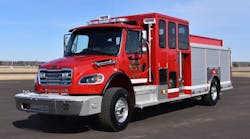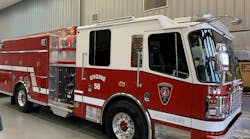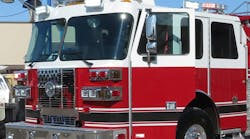In the January installment of The Apparatus Architect, we began covering some considerations for the use of ground ladders on the fireground, together with reasons why your department should carry additional ground ladders on your ladder company units.
Each year, there are several stories that highlight the importance of good truck company operations and ground ladder use at the scene of seemingly "routine" fires. Carrying the proper ground ladders and equipment together with adequate training and unit staffing will go a long way to making the fireground a safer place for our personnel.
One of the first considerations to determine when evaluating ground ladders is the appropriate length of ladder to carry and style of ladder to be carried. While we recognize that a number of departments operate with wooden ground ladders built commercially or supplied by their department shops, this article concentrates on aluminum ground ladders for comparison purposes.
First, let's look at a two-section, 28-foot extension ladder and differences in construction and dimensions. One manufacturer of aluminum ladders offers a pumper-style ladder with a solid beam that is 22 inches wide, 16 feet seven inches in length when closed, with a banking thickness of just under six inches. This ladder weighs 114 pounds and can easily be thrown with two personnel. The same ladder with a truss-style design is 22¼ inches wide, 16 feet six inches in length when closed, with a banking thickness of 67/16 inches. The weight of this ladder is 118 pounds, not significantly heavier than the solid-beam extension ladder. Compare these two-section ladders to their three-section counterparts. While the overall closed length shrinks to 13 feet four inches, the width increases to 25 inches, banking thickness increases to 8¼ inches and the weight dramatically increases to 145 pounds for the solid-beam, pumper-style ladder. So why are all of these dimensions and weights important?
When competing for space inside of the apparatus body, the available area for ground ladder banking is largely determined by the other components that share this area, such as transverse compartments, the water tank and hosebed storage. The critical dimension that limits ground ladder banking is the available length inside of the body. For this reason, many apparatus manufacturers prefer to use three-section ladders for 28-foot and 35-foot extension ladders. While the retracted length of the three-section ladder affords some benefits, the banking thickness requires more space and the weight increases as well.
In addition, there are significant differences in each of these critical dimensions and weight of these ladders between the two major producers of aluminum ground ladders that supply their products for fire service use. For this reason, it is important that the apparatus committee carefully study the characteristics and dimensional differences in each product to determine which model and style of ladder will best meet their needs. Most manufacturers possess the capability to produce detailed ground ladder banking drawings prior to contract to enable the department to visualize exactly how the ground ladders will fit within the available space on the apparatus.
Ground ladders can be stored in a number of locations on the apparatus, including inside of the body under the turntable on rear-mount devices, on top of the body compartments where the ladders would be exposed and can be deployed without consideration to apparatus, and on the ladder or aerial device itself. There are advantages to each of these mounting locations that must be considered when designing new apparatus. When all ladders are enclosed within the apparatus body, they are generally protected from road debris, salt and other hazards that can increase ground ladder maintenance. While this may be the preferred method for ground ladder storage, there are practical limitations as to the maximum number and size of ladders that can fit into this space as well as fireground considerations where apparatus placement can dictate how easily the ground ladders can be removed from the unit and deployed at the incident.
Ground ladders located at the rear of the apparatus can be banked in a horizontal plane or on beam, where the ladders are mounted on beam. Depending on the required overall travel height of the apparatus, it may be necessary to bank all of the ladders horizontally to let ladders nest within one another, thereby increasing the number of ladders that can be carried. The trade-off here is that less-used heavier ladders must be positioned at the bottom of the ladder bed and often requires that one ladder must be removed to gain access to another ladder.
The College Park, MD, Volunteer Fire Department operates a rear-mount aerial that employs both styles of ladder banking where the three-section, 45-foot bangor ladder is nested at the bottom of the ladder bay with a roof ladder banked inside of this ladder. The available space of Truck 812 was used to locate a 28-foot, two-section ladder together with a 16-foot extension ladder mounted on beam at the right side of the ladder bay. Truck 812 also carries a pair of 35-foot, two-section extension ladders together with several roof ladders, totaling 201 feet of ladders mounted inside of the apparatus body.
When the overall height of the apparatus is less of a consideration, ground ladders can be individually mounted on beam, which provides for easier and more rapid access to each ladder. The Rockland, ME, Fire Department operates a well-designed mid-mount tower ladder that carries 162 feet of enclosed ground ladders, including 16-, 18- and 20-foot roof ladders in addition to 10 pike poles and roof hooks of various configurations. The department marked the foot spur of each ladder to clearly identify its length for ease of identification on the fireground.
For departments that operate on narrow streets, or where access to the rear of the unit is limited, it may be preferable to mount the ladders on the exterior of the body for ease of deployment. This style of ladder banking is typically limited only by the length of the apparatus body and the available height on each side to individually mount the ladders within the ladder storage rack. The Syracuse, NY, Fire Department operates a fleet of Sutphen aerial towers as its ladder companies and is equipped with 10 ladders of various lengths, totaling 216 feet. This method of ground ladder banking permits heavier two-section ladders to be positioned lower to the ground with the lighter roof ladders carried above the extension ladders.
Roof ladders can also be carried on aerial devices mounted alongside of the base section of the ladder or within the fly section on some units. Care should be exercised to locate ladders on the side opposite of the turntable pedestal when mounting these on the base section to eliminate blind spots for the operator who is viewing up the ladder while positioning the aerial device.
Ground ladder placement on any type of aerial device is critical to the overall mission of the apparatus. Careful consideration to the type, size, banking thickness and weight of the ground ladder is necessary when determining the proper number and placement of the ladders on your new apparatus. Take the time to review the buildings and geographic hazards in your first-due area before heading to the truck committee meeting with the apparatus manufacturer. This is one area where you are only going to get one shot at making the right decision, which can impact your department's ladder company operations for many years to come.
TOM SHAND, a Firehouse® contributing editor, is a 36-year veteran of the fire service and works with Michael Wilbur at Emergency Vehicle Response, consulting on a variety of fire apparatus and fire department master-planning issues.
MICHAEL WILBUR, a Firehouse® contributing editor, is a lieutenant in the New York City Fire Department, assigned to Ladder Company 27 in the Bronx, and has served on the FDNY Apparatus Purchasing Committee. He consults on a variety of apparatus-related issues around the country. For further information, access his website at www.emergencyvehicleresponse.com.





